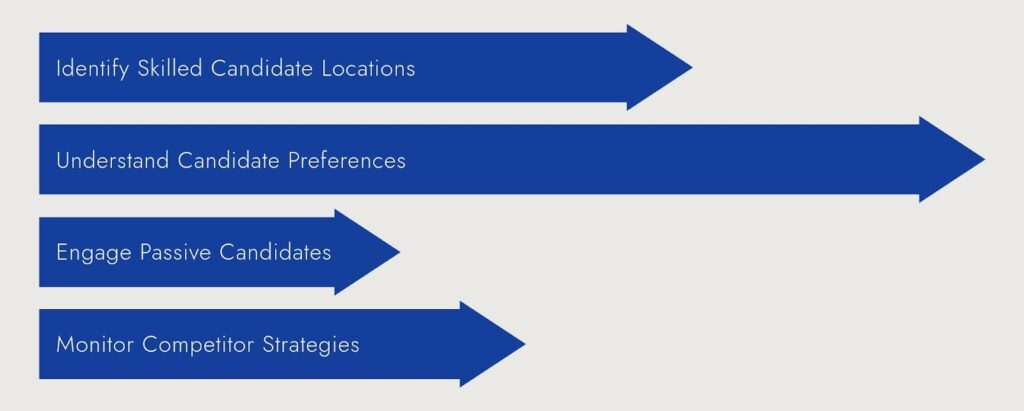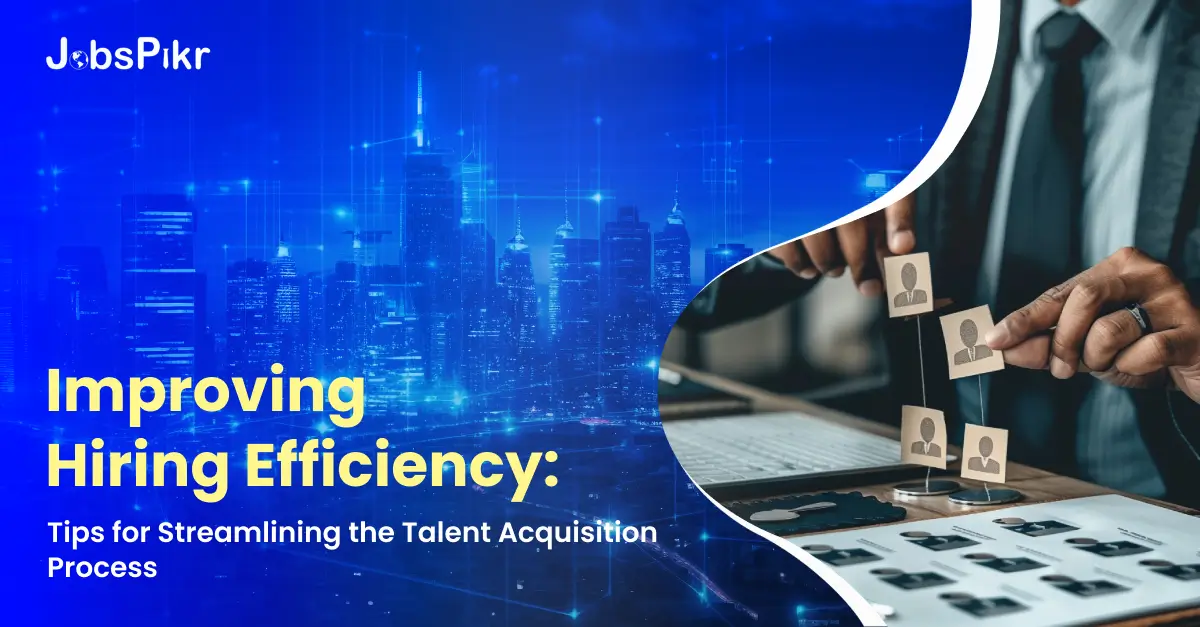In today’s dynamic talent market, hiring efficiency is a critical factor that determines a company’s ability to stay competitive and secure top talent. HR tech companies are continually seeking ways to refine their recruitment strategies to meet the demands of evolving talent market trends. To thrive in this environment, organizations must streamline their talent acquisition processes, leverage cutting-edge technologies, and optimize recruitment workflows.
This blog dives into actionable strategies for improving hiring efficiency, explores key metrics for evaluation, and provides insights into leveraging talent market intelligence to stay ahead of the competition.
Why Hiring Efficiency is Critical in a Competitive Talent Market?

Hiring efficiency refers to the ability of an organization to attract, assess, and onboard top candidates swiftly without compromising the quality of hires. In a highly competitive talent market, delays in the hiring process can result in losing skilled candidates to competitors.
Moreover, inefficient recruitment processes can lead to increased costs, lower team productivity, and a negative employer brand. By focusing on hiring efficiency, HR teams can reduce time-to-hire, improve recruiting efficiency, and align their efforts with broader talent market trends.
Top Strategies to Enhance Hiring Efficiency
1. Streamline Recruitment Workflows
A well-structured recruitment workflow is the backbone of hiring efficiency. Disorganized processes often lead to delays, redundancies, and miscommunication. Consider these steps:
- Map the Candidate Journey: Outline every touchpoint from job application to onboarding. This provides clarity and identifies potential bottlenecks.
- Centralize Communication: Use a recruitment management platform to keep all stakeholders informed and on the same page.
- Automate Administrative Tasks: Automate repetitive tasks like interview scheduling, sending follow-up emails, and document collection to free up recruiters for high-value activities.
2. Leverage Candidate Matching Tools
Implementing AI-powered candidate matching tools can revolutionize the way organizations identify suitable candidates. These tools analyze resumes and job descriptions to rank candidates based on relevance, improving both speed and quality in hiring decisions.
Benefits of AI in Recruiting Efficiency:
- Reduces manual screening time.
- Matches candidates to roles based on skills, experience, and cultural fit.
- Enhances decision-making with data-driven insights.
By integrating such tools into recruitment workflows, HR teams can align with current talent market trends and meet the expectations of tech-savvy candidates.
3. Shorten Time-to-Hire
Time-to-hire is one of the most critical metrics for hiring efficiency. The longer a position remains open, the higher the recruitment costs and potential disruption to operations.
- Set Clear Timelines: Establish benchmarks for each stage of the hiring process.
- Build a Talent Pipeline: Create a pool of pre-qualified candidates for future openings.
- Improve Job Descriptions: Clear and detailed job postings attract the right candidates and minimize back-and-forth during screening.
4. Enhance Candidate Experience
A positive candidate experience can significantly impact hiring efficiency. Happy candidates are more likely to accept offers and refer others to the organization.
- Simplify the Application Process: Avoid lengthy forms and streamline application submission.
- Provide Timely Updates: Regular communication reassures candidates and reduces dropout rates.
- Collect Feedback: Use candidate feedback to improve recruitment workflows and align with talent market intelligence.
5. Leverage Talent Market Intelligence
Understanding talent market trends is essential for fine-tuning hiring strategies. Talent market intelligence helps recruiters identify where skilled candidates are, what they value in an employer, and how to engage them effectively.

- Use Data Analytics: Track industry trends, salary benchmarks, and candidate preferences.
- Stay Ahead of Competitors: Monitor competitors’ hiring strategies and adapt accordingly.
- Engage Passive Candidates: With insights into the talent market, HR teams can proactively reach out to passive candidates who may not be actively looking for opportunities.
How to Measure and Optimize Hiring Efficiency with Key Metrics?
1. Time-to-Hire
Measure the time taken from when a candidate enters the recruitment pipeline to when they accept an offer. A shorter time-to-hire indicates greater hiring efficiency.
2. Cost-per-Hire
This metric evaluates the total expenses incurred in filling a position. Lowering cost-per-hire while maintaining quality is a sign of recruiting efficiency.
3. Quality of Hire
Evaluate the performance and retention rate of new hires to ensure that faster hiring processes do not compromise candidate quality.
4. Application Drop-off Rate
Track the percentage of candidates who abandon the application process. High drop-off rates signal inefficiencies in the application workflow.
5. Offer Acceptance Rate
This metric reveals how many candidates accept offers versus those who decline. A low acceptance rate may indicate issues with the employer brand, salary alignment, or candidate experience.
How to Adapt to Evolving Talent Market Trends?
To stay relevant in a competitive talent market, HR tech companies must align their strategies with emerging trends. Here are some key trends shaping hiring efficiency today:

- Remote Work and Global Talent Pools: The shift to remote work has expanded the talent market, enabling companies to hire beyond geographical boundaries.
- Emphasis on DEI (Diversity, Equity, and Inclusion): Incorporating DEI initiatives in recruitment workflows attracts a diverse range of candidates and enhances hiring efficiency.
- Upskilling and Reskilling: Candidates increasingly value opportunities for growth. Organizations focusing on professional development have a competitive edge.
- Employer Branding: A strong employer brand is critical for attracting top talent in a competitive market.
By staying informed about these trends, HR teams can refine their strategies, improve recruiting efficiency, and gain a competitive edge.
How Technology Can Boost Hiring Efficiency?
- Applicant Tracking Systems (ATS)
An ATS simplifies managing applications, tracking candidates, and generating actionable insights.
- AI and Machine Learning
These technologies enhance candidate screening, predict job fit, and automate repetitive tasks.
- Video Interviewing Tools
Virtual interviews save time and allow recruiters to assess candidates from anywhere, aligning with the global talent market trend.
- Talent Market Intelligence Platforms
Tools that provide real-time data on talent availability, market conditions, and competitor strategies enable better decision-making.
Conclusion
Improving hiring efficiency is no longer optional for HR tech companies navigating today’s fast-paced talent market. By streamlining recruitment workflows, leveraging AI-powered tools, and aligning with talent market trends, organizations can reduce time-to-hire, enhance candidate experience, and optimize recruitment processes.
By focusing on key metrics such as time-to-hire, cost-per-hire, and offer acceptance rates, HR teams can continuously refine their strategies. Additionally, integrating talent market intelligence into hiring processes ensures that recruitment efforts remain aligned with industry shifts and evolving candidate expectations.
Incorporating these strategies not only enhances recruiting efficiency but also positions your organization as a leader in the competitive talent market. Adopting a proactive and data-driven approach to talent acquisition is the key to long-term success.
Ready to revolutionize your hiring efficiency? Explore our cutting-edge HR tech solutions and take the first step towards streamlining your talent acquisition process. Let’s transform the way you hire — Sign-up on JobsPikr today!



